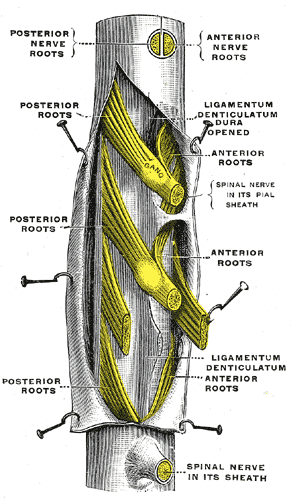Ventral root of spinal nerve
(Redirected from Ventral root)
Ventral Root of Spinal Nerve[edit | edit source]
The ventral root of a spinal nerve is one of the two roots of a spinal nerve that passes ventrally from the spinal cord and consists of motor fibers. It is responsible for transmitting motor information from the central nervous system to the peripheral nervous system, thereby enabling movement and motor control.
Structure[edit | edit source]
The ventral root is composed of axons from motor neurons located in the anterior horn of the spinal cord's gray matter. These axons exit the spinal cord through the ventral rootlets, which converge to form the ventral root. The ventral root then joins with the dorsal root, which contains sensory fibers, to form a mixed spinal nerve.
Function[edit | edit source]
The primary function of the ventral root is to carry motor signals from the spinal cord to the muscles. These signals originate from the motor cortex of the brain, travel down the spinal cord, and exit through the ventral root to reach the target muscles. This pathway is crucial for voluntary muscle movements and reflex actions.
Clinical Significance[edit | edit source]
Damage to the ventral root can result in motor deficits, such as muscle weakness or paralysis, in the affected area. Conditions such as amyotrophic lateral sclerosis (ALS) and poliomyelitis can affect the motor neurons whose axons form the ventral root, leading to significant motor impairment.
Images[edit | edit source]
Related Pages[edit | edit source]
References[edit | edit source]
- Standring, S. (2016). Gray's Anatomy: The Anatomical Basis of Clinical Practice. 41st Edition. Elsevier.
- Purves, D., Augustine, G. J., Fitzpatrick, D., et al. (2001). Neuroscience. 2nd Edition. Sinauer Associates.
Search WikiMD
Ad.Tired of being Overweight? Try W8MD's physician weight loss program.
Semaglutide (Ozempic / Wegovy and Tirzepatide (Mounjaro / Zepbound) available.
Advertise on WikiMD
|
WikiMD's Wellness Encyclopedia |
| Let Food Be Thy Medicine Medicine Thy Food - Hippocrates |
Translate this page: - East Asian
中文,
日本,
한국어,
South Asian
हिन्दी,
தமிழ்,
తెలుగు,
Urdu,
ಕನ್ನಡ,
Southeast Asian
Indonesian,
Vietnamese,
Thai,
မြန်မာဘာသာ,
বাংলা
European
español,
Deutsch,
français,
Greek,
português do Brasil,
polski,
română,
русский,
Nederlands,
norsk,
svenska,
suomi,
Italian
Middle Eastern & African
عربى,
Turkish,
Persian,
Hebrew,
Afrikaans,
isiZulu,
Kiswahili,
Other
Bulgarian,
Hungarian,
Czech,
Swedish,
മലയാളം,
मराठी,
ਪੰਜਾਬੀ,
ગુજરાતી,
Portuguese,
Ukrainian
Medical Disclaimer: WikiMD is not a substitute for professional medical advice. The information on WikiMD is provided as an information resource only, may be incorrect, outdated or misleading, and is not to be used or relied on for any diagnostic or treatment purposes. Please consult your health care provider before making any healthcare decisions or for guidance about a specific medical condition. WikiMD expressly disclaims responsibility, and shall have no liability, for any damages, loss, injury, or liability whatsoever suffered as a result of your reliance on the information contained in this site. By visiting this site you agree to the foregoing terms and conditions, which may from time to time be changed or supplemented by WikiMD. If you do not agree to the foregoing terms and conditions, you should not enter or use this site. See full disclaimer.
Credits:Most images are courtesy of Wikimedia commons, and templates, categories Wikipedia, licensed under CC BY SA or similar.
Contributors: Prab R. Tumpati, MD














